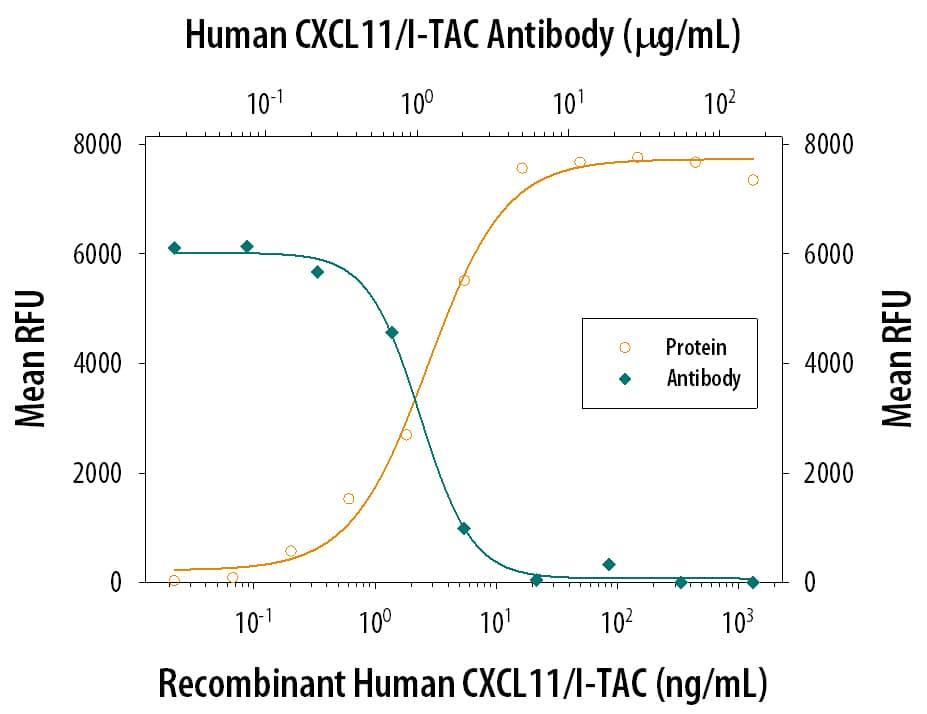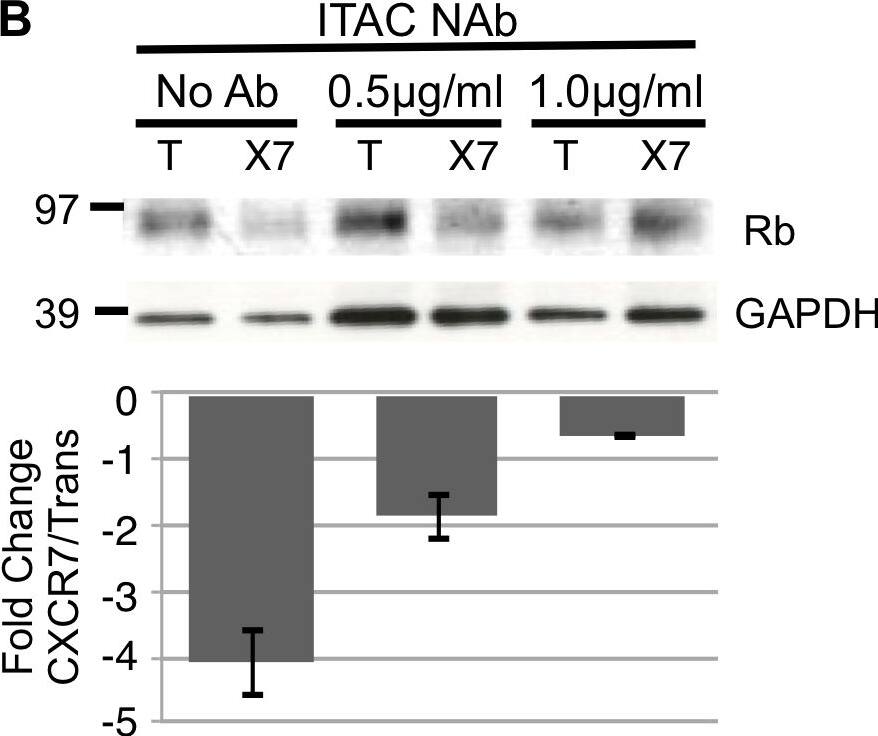Human CXCL11/I-TAC Antibody
R&D Systems, part of Bio-Techne | Catalog # AF260


Key Product Details
Species Reactivity
Validated:
Cited:
Applications
Validated:
Cited:
Label
Antibody Source
Product Specifications
Immunogen
Phe22-Phe94
Accession # O14625
Specificity
Clonality
Host
Isotype
Endotoxin Level
Scientific Data Images for Human CXCL11/I-TAC Antibody
Chemotaxis Induced by CXCL11/I‑TAC and Neutralization by Human CXCL11/I‑TAC Antibody.
Recombinant Human CXCL11/I-TAC (Catalog # 672-IT) chemoattracts the BaF3 mouse pro-B cell line transfected with human CXCR3 in a dose-dependent manner (orange line). The amount of cells that migrated through to the lower chemotaxis chamber was measured by Resazurin (Catalog # AR002). Chemotaxis elicited by Recombinant Human CXCL11/I-TAC (0.05 µg/mL) is neutralized (green line) by increasing concentrations of Goat Anti-Human CXCL11/I-TAC Antigen Affinity-purified Polyclonal Antibody (Catalog # AF260). The ND50 is typically 0.5-1.5 µg/mL.Detection of Human CXCL11/I-TAC by Block/Neutralize
CXCR7-mediated Rb degradation requires ligand.pLEC cultures were infected with Trans only or Trans+CXCR7. At 6 hours post-infection, media was replaced with media only or media containing (A) SDF-1/CXCL12 neutralizing antibody at 1.5, or 3.0 µg/ml or (B) ITAC/CXCL11 neutralizing antibody at 0.5 or 1.0 µg/ml. At 20 hours post infection, cells were lysed and analyzed by western blot for total Rb levels. Densitometry analysis was performed and fold change values were calculated from GAPDH-normalized optical density ratios as described for Figure 3. Bar graphs (bottom) represent the average fold change at each condition for two independent experiments. Image collected and cropped by CiteAb from the following open publication (https://dx.plos.org/10.1371/journal.pone.0069828), licensed under a CC-BY license. Not internally tested by R&D Systems.Detection of Human CXCL11/I-TAC by Block/Neutralize
CXCR7-mediated Rb degradation requires ligand.pLEC cultures were infected with Trans only or Trans+CXCR7. At 6 hours post-infection, media was replaced with media only or media containing (A) SDF-1/CXCL12 neutralizing antibody at 1.5, or 3.0 µg/ml or (B) ITAC/CXCL11 neutralizing antibody at 0.5 or 1.0 µg/ml. At 20 hours post infection, cells were lysed and analyzed by western blot for total Rb levels. Densitometry analysis was performed and fold change values were calculated from GAPDH-normalized optical density ratios as described for Figure 3. Bar graphs (bottom) represent the average fold change at each condition for two independent experiments. Image collected and cropped by CiteAb from the following open publication (https://dx.plos.org/10.1371/journal.pone.0069828), licensed under a CC-BY license. Not internally tested by R&D Systems.Applications for Human CXCL11/I-TAC Antibody
Western Blot
Sample: Recombinant Human CXCL11/I-TAC (Catalog # 672-IT)
Neutralization
Reviewed Applications
Read 1 review rated 5 using AF260 in the following applications:
Formulation, Preparation, and Storage
Purification
Reconstitution
Formulation
Shipping
Stability & Storage
- 12 months from date of receipt, -20 to -70 °C as supplied.
- 1 month, 2 to 8 °C under sterile conditions after reconstitution.
- 6 months, -20 to -70 °C under sterile conditions after reconstitution.
Background: CXCL11/I-TAC
CXCL11, also known as I-TAC, SCYB9B, H174 and beta-R1, is a non-ELR CXC chemokine. CXCL11 cDNA encodes a 94 amino acid (aa) residue precursor protein with a 21 aa residue putative signal sequence, which is cleaved to form the mature 73 aa residue protein. CXCL11 shares 36% and 37% amino acid sequence homology with IP-10 and MIG (two other known human non-ELR CXC chemokines), respectively. CXCL11 is expressed at low levels in normal tissues including thymus, spleen and pancreas. The expression of CXCL11 mRNA is radically up regulated in IFN-gamma and IL-1 stimulated astrocytes. Moderate increase in expression is also observed in stimulated monocytes. CXCL11 has potent chemoattractant activity for IL-2 activated T cells and transfected cell lines expressing CXCR3, but not freshly isolated T cells, neutrophils, or monocytes. The gene encoding CXCL11 has been mapped to chromosome 4.
References
- Cole, K. et al. (1998) J. Exp. Med. 187:2009.
- Sandhya Rani, M. et al. (1996) J. Biol. Chem. 271:22878.
- Lou, Y. et al. (1998) J. Neurovirol. 4:575.
Alternate Names
Gene Symbol
UniProt
Additional CXCL11/I-TAC Products
Product Documents for Human CXCL11/I-TAC Antibody
Product Specific Notices for Human CXCL11/I-TAC Antibody
For research use only

